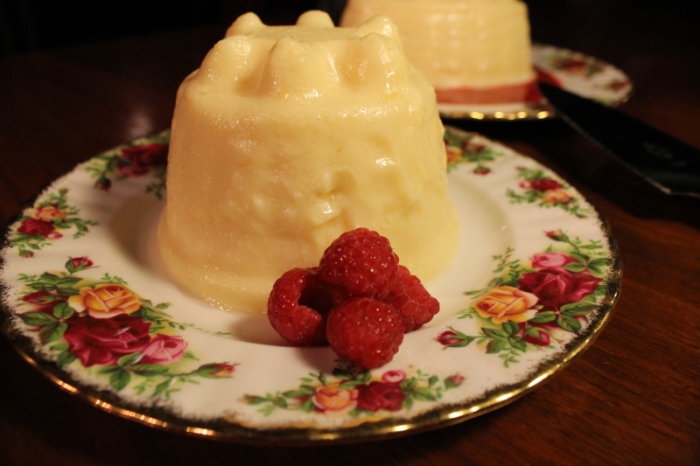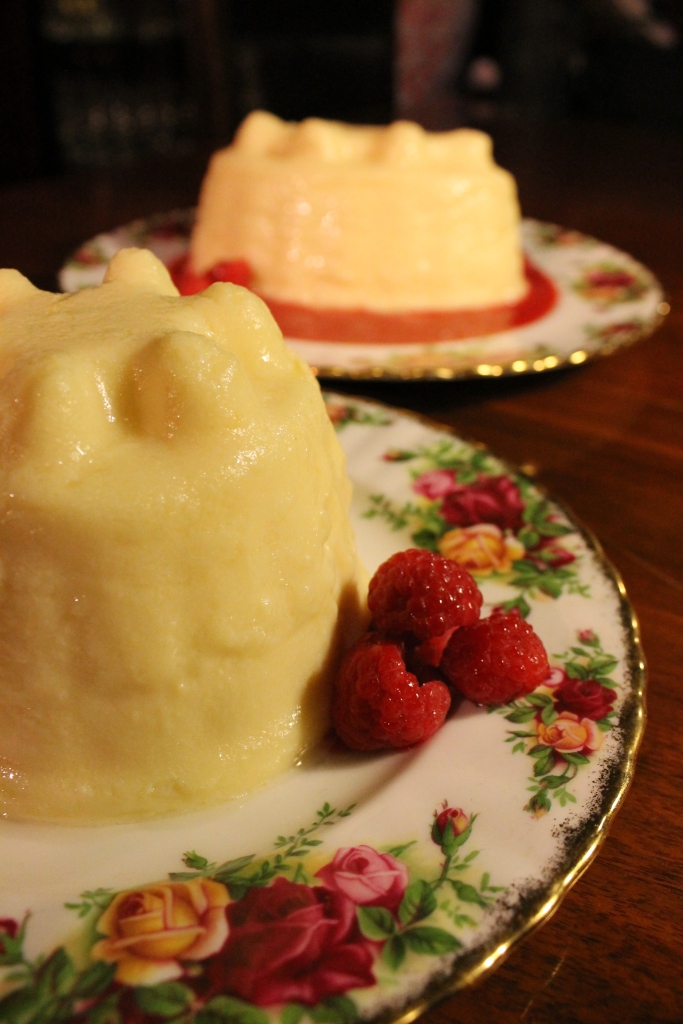First of all, apologies that it’s been a while, between exams, moving and Christmas its been a bit crazy but better late than never. The challenge this time was “Fear Factor”, no not the TV show but a dish, technique or ingredient that strikes fear into your very heart. For me the obvious answer was calves foot jelly, a moulded jelly made by boiling calves feet for hours to extract the gelatine. Between the ick factor, the sheer amount of effort involved and the scariness of unmoulding a jelly, I’m sure you can understand why this dish has me shaking in my boots.
Unfortunately (or fortunately?) I seriously underestimated how difficult it would be to find calves feet. Thinking about the recipe again though, I realised that the part that really strikes fear into my heart is setting and unmoulding the jelly, and that can certainly be done without extracting my own gelatine. If however you are really keen to learn about calves feet jelly, the amazing blog The Cook and the Curator has a great video about making it from scratch.
The recipe I decided to use comes from Mrs. Beeton’s The Book of Household Management and is for a Lemon Blancmange. Blancmange is a dish with a very long history, but has become almost unrecognisable over time. It’s a staple of medieval and Victorian cookbooks, whether as a white soup made of shredded chicken and almond milk, or an elaborate jelly set with isinglass.
The Recipe
LEMON BLANCMANGE. 1442.
INGREDIENTS.— 1 quart of milk, the yolks of 4 eggs, 3 oz. of ground rice, 6 oz. of pounded sugar, 1-1/2 oz. of fresh butter, the rind of 1 lemon, the juice of 2, 1/2 oz. of gelatine.
Mode.— Make a custard with the yolks of the eggs and 1/2 pint of the milk, and, when done, put it into a basin: put half the remainder of the milk into a saucepan with the ground rice, fresh butter, lemon-rind, and 3 oz. of the sugar, and let these ingredients boil until the mixture is stiff, stirring them continually; when done, pour it into the bowl where the custard is, mixing both well together. Put the gelatine with the rest of the milk into a saucepan, and let it stand by the side of the fire to dissolve; boil for a minute or two, stir carefully into the basin, adding 3 oz. more of pounded sugar. When cold, stir in the lemon-juice, which should be carefully strained, and pour the mixture into a well-oiled mould, leaving out the lemon-peel, and set the mould in a pan of cold water until wanted for table. Use eggs that have rich-looking yolks; and, should the weather be very warm, rather a larger proportion of gelatine must be allowed.
Time.— Altogether, 1 hour. Average cost, 1s. 6d. Sufficient to fill 2 small moulds. Seasonable at any time.[1]
The Redaction
Mrs Beeton’s Lemon Blancmange
4 cups of milk
4 egg yolks
85g ground rice
170g sugar
43g butter
The rind of 1 lemon, peeled
Juice of 2 lemons
14g powdered gelatine
Note: Every time you go to place milk in the saucepan wet it with water first.
- Place 1 cup of milk in a saucepan and bring it to a slow simmer. In a large bowl whisk the 4 egg yolks together. Slowly whisk the hot milk into the egg yolks until it is all incorporated. Place the mixture back into the saucepan and cook on a low heat, stirring constantly until it thickens into a custard*.
- Place another 1 1/2 cups of milk into the saucepan with the ground rice, half the sugar, the butter and pieces of lemon rind. Boil for 5-10 minutes or until it is stiff and holds its shape. Stir this mixture into the custard.
- Place the remaining 1 1/2 cups of milk into the saucepan. Sprinkle the gelatine over the milk and allow it to dissolve. Turn on a low heat and stir until dissolved before bringing it to the boil for 1 minute. Add this and the remaining sugar to the custard.
- Allow the mixture to cool before adding the lemon juice and removing the lemon peel. Pour the mixture into moulds greased with a flavourless oil and leave in the fridge to set. To remove place the mould in very hot water for 30 seconds, but don’t let the blancmange get wet, and just loosen the edge to break the vacuum. Carefully turn the blancmange out onto a plate. If it does not come out of the mould return it to the hot water for another 30 seconds before trying again.
*If the mixture is lumpy with bits of egg just sieve them out.
The Recipe: Lemon Blancmange from The Book of Household Management (available here)
The Date: 1861
How did you make it? See above.
Time to complete?: 45 mins to make it, several hours to set.
How successful was it?: It was delicious! Creamy, firm and not too sweet, it even turned out of the mould well, after a couple of anxious moments. I served it with a simple raspberry coulis of frozen raspberries, water and sugar cooked and mashed together.
How accurate?: I’m not sure what type of gelatine the original recipe would have used (powdered, leaf, liquid?) or how finely ground the rice should be but it seemed to work. I also set it in the fridge rather than in a bowl of cold water because the weather was too warm for that.
[1] Isabella Beeton, ed., Beeton’s Book of Household Management (London: S.O Beeton, 1861), rec. 1442.
Bibliography
Beeton, Isabella, ed. Beeton’s Book of Household Management. London: S.O Beeton, 1861.





